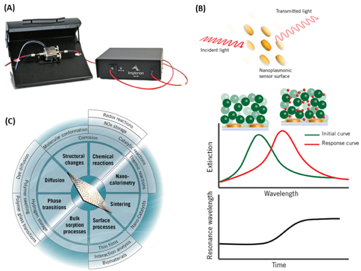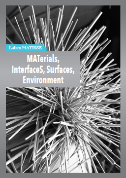NanoPlasmonic Sensing
Fiche technique
- Intitulé : NanoPlasmonic Sensing (Insplorion XNano and Acoulyte Instrument)
- Thème : The Insplorion XNano modular system provides the opportunity to study processes occurring within or on nanomaterials and at interfaces. Insplorion Acoulyte allows simultaneous real time measurements with Nanoplasmonic Spectroscopy and Quartz Crystal Microbalance with Dissipation monitoring (QCMD)
- Financement :
- MATISSE : 60%
- ANR UpPhotoCat : 40%
- Responsable scientifique du projet : Souhir Boujday
Laboratoire de Réactivité de Surface - Co-porteurs :
- Bruno Gallas
Institut des NanoSciences de Paris - Juliette Blanchard
Laboratoire de Réactivité de Surface
- Bruno Gallas
- Localisation : Laboratoire de Réactivité de surface
Présentation du projet scientifique
Interest of Insplorion XNano Instrument
The Insplorion XNano features a flexible measurement cell, enabling real-time refractive index change measurements in both gas- and liquid flow measurements. The XNano provides the user with a versatile system, which makes all the exciting possibilities of the Insplorion NPS technology easily accessible.
- Ultra sensitive measurement of refractive index change at the sensor surface
- Measure in liquid or gas environment
- Temperature range ambient to 80°C using integrated temp control
- Flexible choice of sample material structure and properties
- lexible choice of substrate material and surface chemistry
- Monitor processes in/on nanoparticles, nanostructures and thin films
- Suitable for any sample material: Soft, Hard, metallic, ceramic, polymeric, biomolecular, porous, conducting or insulating
- Real-time analysis: Measure with sub-second temporal resolution
- In-situ measurements: Measure in liquid or in air at select temperature
- System: optics unit, temperature control unit, liquid handling system, measurement cell and computer with Insplorer software
Nanoplasmonic Sensing by Insplorion
NanoPlasmonic Sensing (NPS) is extremely robust, non-invasive, sensitive, and offers high temporal resolution. The nanostructured NPS sensor is the key component of the XNano instrument. The technology is based on the optical phenomenon of Localized Surface Plasmon Resonance (LSPR) in metal nanoparticles. The individual plasmonic particles act as nano-sized optical sensors or antennas. The plasmonic particles exhibit a resonance wavelength at which the extinction of incident light is maximal. The resonance wavelength is extremely sensitive to any changes in molecular concentration or composition in the immediate vicinity (<50 nm) of the plasmonic particle.
The following figure 1 illustrate The Insplorion XNano Instrument (Figure 1A) and the principle of this technique on the optical phenomenon of Localized Surface Plasmon Resonance (LSPR) in metal nanoparticles. By monitoring shifts in the resonance wavelength in real time, it is possible to follow for example, the binding kinetics of a small molecular species in a porous film (Figure 1B). Many different processes and systems can be studied with the XNano system (Figure°1C). https://www.insplorion.com/en/products/insplorion-xnano-ii/

Interest of Insplorion Acoulyte Instrument
Combine optical spectroscopy with QCM-D. Simultaneous real time measurements with Nanoplasmonic Spectroscopy (NPS) and Quartz Crystal Microbalance with Dissipation monitoring (QCM-D). Q-Sense QCM-D technology utilizes an oscillating quartz disc to measure the mass and viscoelasticity of thin films on the disc surface. The resonance frequency of the oscillation decreases when a thin film is attached to the sensor. By measuring the dissipation, it is possible to determine if the adsorbed film is rigid or viscoelastic (soft).
- Obtain real-time changes in dry mass (refractive index), wet (acoustic) mass, and viscoelasticity for the same sample on the same surface and at the same time
- Measure simultaneously under identical experimental conditions using Insplorion’s Nanoplasmonic Spectroscopy (NPS) and Q-Sense’s Quartz Crystal Microbalance with Dissipation monitoring (QCM-D)
- Molecular organization/conformation: Combined NPS and QCM-D measurements will help interprete the signals from molecular adsorption, conformational changes and solvent loss.
- Molecular desorption (adsorption): Time- and depth resolved measurement of molecular desorption (adsorption) from thick films (<~1 μm). Using the Acoulyte it is also possible to discriminate swelling from adsorption / desorption events
- Lipid bilayers: The Acoulyte enables more detailed interpretation of the formation process of thin surface films
The figure 2 illustrate the molecular organization/conformation (Figure 2A) and molecular desorption (adsorption) (Figure 2B). https://www.insplorion.com/en/products/insplorion-acoulyte/

Communication
Insplorion Company has published on their Websites and professional network (Linkedn):
- https://www.insplorion.com/en/news/20181130/
- https://www.insplorion.com/en/20181211/
- https://www.linkedin.com/feed/update/urn:li:activity:6478308093972348929
Insplorion sells an XNano system with an Acoulyte ad-on to Professor Souhir Boujday at LRS, Sorbonne University in Paris, which becomes an Insplorion Reference Center.
“Professor Souhir Boujday at Laboratoire de Réactivité de Surface (LRS), Sorbonne University, has experience from Insplorion’s XNano since her time at NTU, Singapore, and a reference center for Insplorion. This is the first sale for Insplorion in France and Professor Souhir Boujday and her group will serve as a reference center for the French market.”
Research Project associated with Insplorion Instrument:
- Exacerbation de dichroïsme circulaire optique et détection de molécules chirales par des nanostructures métalliques
- ChirOptMol
- NanoBioSensor
- UpPhotoCat
Egalement dans la rubrique
- Caractérisation microthermométrique d’inclusions fluides
- Caractérisation multi-fonctions, multi-échelles, in-Operando de Couches par Ellipsometrie Spectroscopique Infrarouge
- Caractérisation sur biopsies de calcifications associées aux pathologies rénales
- Cellule à enclumes de diamants miniature
- Chambre de prétraitement pour spectromètre XPS
- Cryo-plongeur pour la cryo-microscopie électronique
- Cryomicrotomie
- Elasticité des membranes de collagène chargées en nanoparticules et réponse sous champ électrique du collagène
- Etude des mécanismes de réaction à l’interface solide-liquide par spectroscopie IRTF résolue dans le temps
- FluoMatX
- Identification de nouveaux catalyseurs électrochimiques par microscopie électrochimique à balayage (SECM)
- Lithographie UV
- Mesures acoustiques en conditions extrêmes de pression et température.
- Microscopie hyperspectrale pour l'analyse de nano‐objets uniques en lien avec de nouvelles approches pédagogiques de projets tutorés
- Oxydes Conducteurs Transparents par dopage de charge d’espace.
- Sonder l’ordre local des nanomatériaux : développement de la Fonction de Distribution de Paires
MATISSE en chiffres
- 4 disciplines : Chimie, Physique, Sciences de la Terre, Patrimoine
- 400 permanents
Contact
Direction
Florence Babonneau
Administration
Communication
Emmanuel Sautjeau



